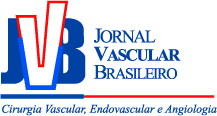Association between critical limb ischemia and arterial stiffness measured by brachial artery oscillometry
Associação entre isquemia crítica do membro e rigidez arterial medida por oscilometria da artéria braquial
Daniel Mendes-Pinto; José Márcio Ribeiro; Maria da Glória Rodrigues-Machado
Abstract
Keywords
Resumo
Resumo:
Palavras-chave
References
Fowkes FGR, Rudan D, Rudan I, et al. Comparison of global estimates of prevalence and risk factors for peripheral artery disease in 2000 and 2010: a systematic review and analysis. Lancet. 2013;382(9901):1329-40. http://dx.doi.org/10.1016/S0140-6736(13)61249-0. PMid:23915883.
Criqui MH, Aboyans V. Epidemiology of peripheral artery disease. Circ Res. 2015;116(9):1509-26. http://dx.doi.org/10.1161/CIRCRESAHA.116.303849. PMid:25908725.
Gerhard-Herman MD, Gornik HL, Barrett C, et al. 2016 AHA/ACC Guideline on the management of patients with lower extremity peripheral artery disease: executive summary: a report of the American College of Cardiology/American Heart Association Task Force on Clinical Practice Guidelines. Circulation. 2017;135(12):e686-e725. PMid:27840332.
Aboyans V, Ricco JB, Bartelink MLEL, et al. Editor’s Choice - 2017 ESC guidelines on the diagnosis and treatment of peripheral arterial diseases, in collaboration with the European Society for Vascular Surgery (ESVS). Eur J Vasc Endovasc Surg. 2018;55(3):305-68. http://dx.doi.org/10.1016/j.ejvs.2017.07.018. PMid:28851596.
Vlachopoulos C, Xaplanteris P, Aboyans V, et al. The role of vascular biomarkers for primary and secondary prevention: a position paper from the European Society of Cardiology Working Group on peripheral circulation. Endorsed by the Association for Research into Arterial Structure and Physiology (ARTERY) Society. Atherosclerosis. 2015;241(2):507-32. http://dx.doi.org/10.1016/j.atherosclerosis.2015.05.007. PMid:26117398.
Boutouyrie P, Briet M, Collin C, Vermeersch S, Pannier B. Assessment of pulse wave velocity. Artery Res. 2009;3(1):3-8. http://dx.doi.org/10.1016/j.artres.2008.11.002.
Townsend RR, Wilkinson IB, Schiffrin EL, et al. Recommendations for improving and standardizing vascular research on arterial stiffness: a scientific statement from the American Heart Association. Hypertension. 2015;66(3):698-722. http://dx.doi.org/10.1161/HYP.0000000000000033. PMid:26160955.
Chirinos JA, Kips JG, Jacobs DR Jr, et al. Arterial wave reflections and incident cardiovascular events and heart failure: MESA (Multiethnic Study of Atherosclerosis). J Am Coll Cardiol. 2012;60(21):2170-7. http://dx.doi.org/10.1016/j.jacc.2012.07.054. PMid:23103044.
Kals J, Lieberg J, Kampus P, Zagura M, Eha J, Zilmer M. Prognostic impact of arterial stiffness in patients with symptomatic peripheral arterial disease. Eur J Vasc Endovasc Surg. 2014;48(3):308-15. http://dx.doi.org/10.1016/j.ejvs.2014.05.018. PMid:24962743.
Zahner GJ, Gruendl MA, Spaulding KA, et al. Association between arterial stiffness and peripheral artery disease as measured by radial artery tonometry. J Vasc Surg. 2017;66(5):1518-26. http://dx.doi.org/10.1016/j.jvs.2017.06.068. PMid:28756044.
Catalano M, Scandale G, Carzaniga G, et al. Aortic augmentation index in patients with peripheral arterial disease. J Clin Hypertens. 2014;16(11):782-7. http://dx.doi.org/10.1111/jch.12406. PMid:25228305.
Jacomella V, Shenoy A, Mosimann K, Kohler MK, Amann-Vesti B, Husmann M. The impact of endovascular lower-limb revascularisation on the aortic augmentation index in patients with peripheral arterial disease. Eur J Vasc Endovasc Surg. 2013;45(5):497-501. http://dx.doi.org/10.1016/j.ejvs.2013.01.026. PMid:23453515.
Zahner GJ, Spaulding KA, Ramirez JL, et al. Characterizing the relationship between flow-mediated vasodilation and radial artery tonometry in peripheral artery disease. J Surg Res. 2018;224:121-31. http://dx.doi.org/10.1016/j.jss.2017.11.062. PMid:29506827.
Brand M, Woodiwiss AJ, Michel F, Booysen HL, Veller MG, Norton GR. A mismatch between aortic pulse pressure and pulse wave velocity predicts advanced peripheral arterial disease. Eur J Vasc Endovasc Surg. 2013;46(3):338-46. http://dx.doi.org/10.1016/j.ejvs.2013.06.005. PMid:23835110.
Weiss W, Gohlisch C, Harsch-Gladisch C, Tölle M, Zidek W, Van Der Giet M. Oscillometric estimation of central blood pressure: Validation of the Mobil-O-Graph in comparison with the SphygmoCor device. Blood Press Monit. 2012;17(3):128-31. http://dx.doi.org/10.1097/MBP.0b013e328353ff63. PMid:22561735.
Gallagher D, Adji A, O’Rourke MF. Validation of the transfer function technique for generating central from peripheral upper limb pressure waveform. Am J Hypertens. 2004;17(11 Pt 1):1059-67. http://dx.doi.org/10.1016/j.amjhyper.2004.05.027. PMid:15533735.
Beckmann M, Jacomella V, Kohler M, et al. Risk stratification of patients with peripheral arterial disease and abdominal aortic aneurysm using aortic augmentation index. PLoS One. 2015;10(10):1-14. http://dx.doi.org/10.1371/journal.pone.0139887. PMid:26452151.
Sutton-Tyrrell K, Najjar SS, Boudreau RM, et al. Elevated aortic pulse wave velocity, a marker of arterial stiffness, predicts cardiovascular events in well-functioning older adults. Circulation. 2005;111(25):3384-90. http://dx.doi.org/10.1161/CIRCULATIONAHA.104.483628. PMid:15967850.
Khaleghi M, Kullo IJ. Aortic augmentation index is associated with the ankle-brachial index: a community-based study. Atherosclerosis. 2007;195(2):248-53. http://dx.doi.org/10.1016/j.atherosclerosis.2006.12.017. PMid:17254587.
Eldrup N, Sillesen H, Prescott E, Nordestgaard BG. Ankle brachial index, C-reactive protein, and central augmentation index to identify individuals with severe atherosclerosis. Eur Heart J. 2006;27(3):316-22. http://dx.doi.org/10.1093/eurheartj/ehi644. PMid:16278227.
Mattace-Raso F, Hofman A, Verwoert GC, et al. Determinants of pulse wave velocity in healthy people and in the presence of cardiovascular risk factors: ‘establishing normal and reference values.’. Eur Heart J. 2010;31(19):2338-50. http://dx.doi.org/10.1093/eurheartj/ehq165. PMid:20530030.
Nunan D, Wassertheurer S, Lasserson D, et al. Assessment of central haemomodynamics from a brachial cuff in a community setting. BMC Cardiovasc Disord. 2012;12(1):48. http://dx.doi.org/10.1186/1471-2261-12-48. PMid:22734820.
Janner JH, Godtfredsen NS, Ladelund S, Vestbo J, Prescott E. Aortic augmentation index: Reference values in a large unselected population by means of the sphygmocor device. Am J Hypertens. 2010;23(2):180-5. http://dx.doi.org/10.1038/ajh.2009.234. PMid:19959999.
Teodorescu VJ, Vavra AK, Kibbe MR. Peripheral arterial disease in women. J Vasc Surg. 2013;57(4, Suppl):18S-26S. http://dx.doi.org/10.1016/j.jvs.2012.10.115. PMid:23522713.
Yannoutsos A, Ahouah M, Tubiana CD, et al. Hemodynamic parameters in hypertensive diabetic patients. J Hypertens. 2016;34(6):1123-31. http://dx.doi.org/10.1097/HJH.0000000000000898. PMid:26999754.
Kozakova M, Palombo C. Diabetes mellitus, arterial wall, and cardiovascular risk assessment. Int J Environ Res Public Health. 2016;13(2):201. http://dx.doi.org/10.3390/ijerph13020201. PMid:26861377.
Zettervall SL, Buck DB, Darling JD, Lee V, Schermerhorn ML, Guzman RJ. Increased preoperative pulse pressure predicts procedural complications and mortality in patients who undergo tibial interventions for critical limb ischemia. J Vasc Surg. 2016;63(3):673-7. http://dx.doi.org/10.1016/j.jvs.2015.09.033. PMid:26577658.
Kollias A, Protogerou AD, Stergiou GS. Antihypertensive treatment-induced changes in arterial stiffness. J Hypertens. 2017;35(4):721-5. http://dx.doi.org/10.1097/HJH.0000000000001198. PMid:28248902.
Hametner B, Wassertheurer S, Kropf J, Mayer C, Eber B, Weber T. Oscillometric estimation of aortic pulse wave velocity: Comparison with intra-aortic catheter measurements. Blood Press Monit. 2013;18(3):173-6. http://dx.doi.org/10.1097/MBP.0b013e3283614168. PMid:23571229.

